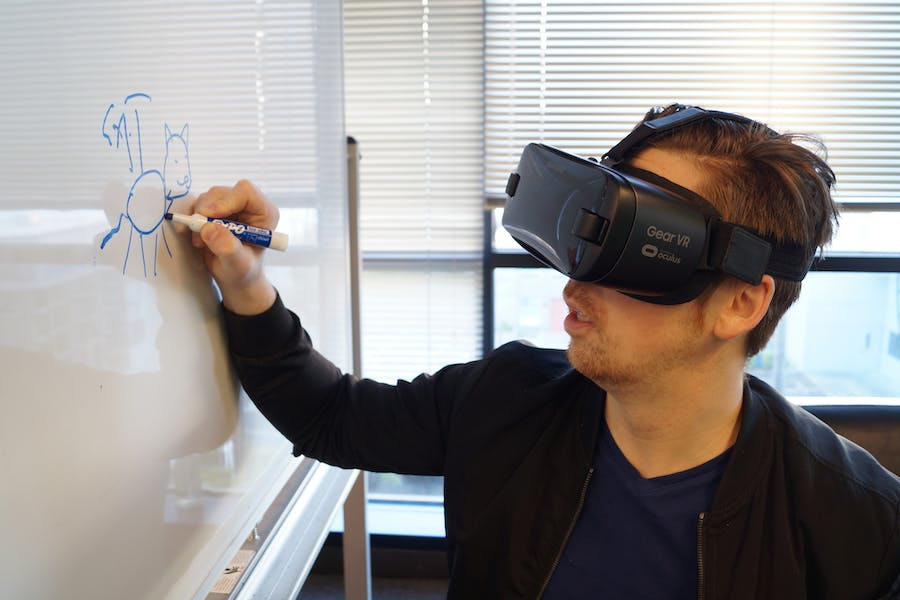
Many individuals, especially those not well-versed in technology, often confuse the metaverse with typical internet activities. However, the metaverse extends far beyond the confines of the internet. It represents a digital universe where people can engage with computer-generated environments and interact with fellow users in real-time, all thanks to contemporary technologies like augmented reality (AR), virtual reality (VR), and three-dimensional (3D) graphics.
Metaverse is dependent on the metaverse development company and available technology. Thus, it is vital to understand the role of modern devices in shaping the metaverse. In this article, let’s dive deep into how modern devices shape the metaverse.
Virtual Reality (VR) Devices: Creating Immersive Experiences
Virtual reality (VR) devices, such as VR headsets, create immersive environments by blocking out the physical world and replacing it with computer-generated simulations. They use computer modeling and simulation to enable a user to interact with an artificial 3D visual or other sensory environment. They are fundamental not only to the evolution of metaverse gaming but to the metaverse as a whole.
Users can explore virtual spaces, interact with objects, and engage with others in ways that feel remarkably real. The metaverse relies heavily on VR devices to deliver a sense of presence, allowing users to feel as if they are physically present in a digital space.
As VR technology continues to advance with improvements in graphics, motion tracking, and tactile feedback, the metaverse becomes more engaging and lifelike.
Augmented Reality (AR) Devices: Blending Virtual and Physical Realities
While VR devices immerse users in entirely virtual spaces, augmented reality (AR) devices overlay digital information onto the physical world. AR devices, such as AR glasses and smartphones equipped with AR capabilities, play a crucial role in shaping the metaverse by seamlessly blending virtual elements with the real world.
AR devices allow users to access information, interact with virtual objects, and engage in shared experiences while remaining connected to their physical surroundings. This integration of virtual and physical realities is a key aspect of the metaverse, fostering a more integrated and versatile digital space.
Smartphones and Accessory Devices: Making Metaverse Available Anytime and Anywhere
As smartphones and other accessory technology devices have become the norm, these devices contribute significantly to the accessibility of the metaverse. They can serve as portals to virtual spaces, allowing users to connect with the metaverse anytime and anywhere.
Moreover, mobile applications and platforms that support metaverse experiences ensure that users can easily access and participate in virtual activities from the palm of their hands.
Wearable devices, such as smartwatches and fitness trackers, may also play a role in the metaverse by providing additional input methods and enhancing the overall user experience. Integrating metaverse functionalities into these devices expands the scope of digital interaction beyond traditional screens.
High-Performance Computing Technologies: Powering Immersive Experiences
The metaverse demands significant computation power to render complex virtual environments and deliver immersive experiences. High-performance computing (HPC) technologies, which include powerful Graphics Processing Units (GPUs) and Central Processing Units (CPUs), are essential for processing the vast amount of data required to create realistic graphics, simulate physical environments, and support real-time interactions.
Additionally, the advancements in cloud computing contribute to the scalability and accessibility of the metaverse. Cloud-based platforms allow users to access computational resources remotely, reducing the hardware requirements for individual devices and facilitating the development of more sophisticated and expansive virtual worlds.
Internet Connectivity: Ensuring Seamless Interaction
A robust and high-speed internet connection is a crucial requirement for a seamless metaverse experience. The metaverse involves real-time interactions, high-quality audio and video streaming, and the exchange of large amounts of data.
The widespread availability of high-speed internet, including 5G technology, ensures that users can engage in the metaverse without experiencing lag or connectivity issues, enhancing the overall user experience.
Artificial Intelligence (AI): Enhancing Virtual Environment
Artificial intelligence (AI) is one of the key drivers in shaping the metaverse by enhancing interactivity and realism. AI algorithms can contribute to creating lifelike characters, simulating natural language interactions, and enabling intelligent behaviors within the virtual environment.
The advancement in AI technology can make the metaverse more dynamic and responsive to user actions to create a more immersive and engaging digital experience.
Final Thoughts
The development of the metaverse is a collaborative effort driven by a range of modern devices and technologies. Virtual reality (VR) and augmented reality (AR) devices provide immersive interfaces, smartphones and accessory devices ensure accessibility, high-performance computing powers and internet connectivity provide realistic simulations, and artificial intelligence (AI) enhances interactivity.
As technology continues to advance, the metaverse will likely become more integrated into our daily lives, offering new opportunities for work, entertainment, education, and social interaction. The ongoing development of modern devices will play a crucial role in shaping the metaverse into a versatile and engaging digital realm.


